This segment is benefitting from and capitalizing on prevalent trends, which include using local, artisan and freshly made products.
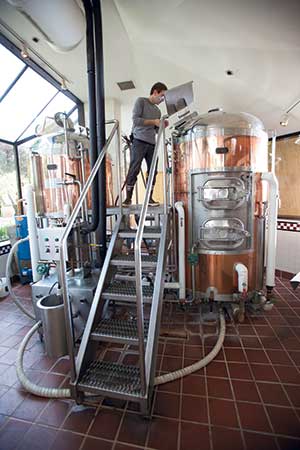 Peter B’s recently increased its beer production to 1,050 barrels — 31 gallons of beer per barrel.Microbreweries continue to do big business as more people seek full-flavored beer and a greater variety of choices. Microbrews, also known as craft beers, also meet consumers' desire to support products that use locally sourced ingredients from independent providers. Millennials, in particular, continue to drive the brew pub and craft beer industries.
Peter B’s recently increased its beer production to 1,050 barrels — 31 gallons of beer per barrel.Microbreweries continue to do big business as more people seek full-flavored beer and a greater variety of choices. Microbrews, also known as craft beers, also meet consumers' desire to support products that use locally sourced ingredients from independent providers. Millennials, in particular, continue to drive the brew pub and craft beer industries.
Restaurants continue to benefit from the beer revolution, since dynamic production growth in craft varietals offers endless food pairing possibilities. "In the last few years, we've seen brewery restaurants break out of the old pub model," says Bart Watson, chief economist at the Boulder, Colo.-based Brewers Association. "Today, breweries are combined with all types of restaurants, from white tablecloth to ethnic. This was only a matter of time, given the creativity on the beer side."
Among the 4,200 breweries in the U.S., 1,600 pair with brew pubs, according to the Brewers Association. Small and independent breweries now make up between 12 percent and 13 percent of U.S. brew volume.
"We've seen production from small independent breweries grow in 8 out of the last 10 years," says Watson. "Numbers are still being finalized, but growth in volume was expected to be 15 percent in 2015, a decrease from 18 percent in 2014. Because there is now a larger base, continuing the growth rate has become more difficult."
The increasing diversity of craft beer continues to drive much of the growth. As brew pubs seek to differentiate in an increasingly competitive market, there have been new twists on IPAs and fruit-infused varieties in the last year. Session-style beers that feature lower alcohol content, such as pilsners and golden ales, remain on the upswing. The same applies to light sours, which feature a higher acidity and pair well with a wide range of food items.
"We're seeing a resurgence in malts, with interesting things being done around local malting and single malts," says Watson. "Also SMaSH beers — single malt and single hop — are big." These beers break down the brewing process into the basic elements, emphasizing the flavor of a SMaSH variety.
Despite the expanding selections of craft beer, the actual brewing process and its equipment remain relatively consistent. "Brewing is one of the oldest biotechnologies, so there's nothing new, other than creating different interpretations and unique flavors," says Watson. "Humans have been fermenting grain for a long time."
There have, however, been developments regulating the industry. Because the rights of brew pubs vary by state in terms of carry-out businesses and retail components, the Brewers Association offers resources to help brew pubs and retailers navigate craft beer program requirements. This includes training and management programs.
State Park Brewing
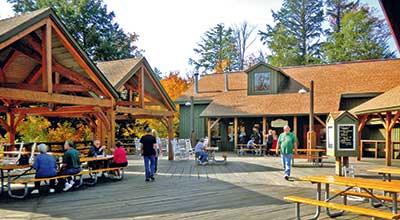 A focal point of Tahquamenon Falls Brewery’s operations is a large deck with outdoor seating.When Michigan's Tahquamenon Falls State Park was created in 1947, the various species of trees and cascading falls were the area's main draw. In 1996 the park also became known for its unique craft brews.
A focal point of Tahquamenon Falls Brewery’s operations is a large deck with outdoor seating.When Michigan's Tahquamenon Falls State Park was created in 1947, the various species of trees and cascading falls were the area's main draw. In 1996 the park also became known for its unique craft brews.
When Tahquamenon Falls Brewery & Pub owner Lark Ludlow and her brother Barrett acquired park property in 1990, it was steeped in family history. Their grandfather purchased 164 acres of prime Upper Falls property in 1949, retaining 2 acres and selling the rest of the land to the state. He built camp-style buildings centered on a grand fireplace, along with a gift shop, prior to his death in 1959.
When the Ludlows took over the property, they debated whether to rebuild the deteriorated buildings or try something different. After researching their options, they decided to open Tahquamenon Falls Brewery & Pub in 1996.
"It's unique to have a brewery within a state park," says Ludlow.
The 85-seat restaurant's decor pays homage to its surroundings, with a camp-style theme, an epoxy floor the color of sand, deep green walls reminiscent of the forest outside, natural maple tabletops, red chairs that bring to mind the iron on oar boats, a bar rail constructed from a retired railroad track and a big fireplace similar to the one Ludlow's grandfather built outdoors under the picnic shelter.
"Fireplaces have always been at the center of Michigan's logging camps not only due to the warmth these provided but also as a place for socialization," says Ludlow.
Ludlow and her brother didn't have restaurant or brewing experience, so they signed on a chef to run the back of house. "I learned brewing from the people I purchased the equipment from," says Ludlow. "I quickly discovered that there is a creativity to making beer, and it has infinite possibilities."
Tahquamenon Falls Brewery uses a 10-barrel system designed by a now-shuttered Bohemian brewery that was
located in Hungary. Sitting opposite the fireplace, the brewery operation remains visible to customers in the dining room. Enhancing the visual appeal, the brew tanks feature copper jackets. "This provides more warmth than stainless steel," Ludlow says. "It's worth the investment but requires more upkeep with constant polishing."
The brewery's system can serve four different beers at one time, and Tahquamenon Falls consistently rotates its offerings. Selections include a lumberjack light lager, which has a 45-day fermentation time, a light harvest wheat, a stout and a porcupine ale. Flavored beer varieties are also popular, including blueberry, cherry and raspberry.
While pale ales tend to be hoppy, Ludlow's are lighter. The brewery also offers Falls Tannin, which reflects the dark red color of the nearby Tahquamenon River.
Although the majority of beer is brewed and consumed on the premises, customers can fill half-gallon growlers to take with them.
"When we first opened, I had to walk around the dining room encouraging customers to try our different beer varieties," says Ludlow. "Now, people are no longer wary of trying microbrews."
Described as a casual fine-dining restaurant, Tahquamenon Falls Brewery & Pub's menu is different from what one might expect to find at a state park. Popular items include fresh whitefish, salmon and trout from nearby Lake Superior. Its homemade pasties, a traditional Upper Peninsula dish, consist of a double crust filled with lean ground beef, potatoes, onions, carrots and rutabaga, baked and served with side of gravy and coleslaw.
"Miners used to heat pasties on their gas lamps while working underground," says Ludlow.
At approximately 30 feet by 30 feet, the kitchen's battery of cooking equipment includes a chargrill for steaks and burgers, two ovens for baking, a broiler and a deep fryer.
With a growing number of visitors to the area, there has been talk about whether to expand the restaurant, which is maxed out on its property lines.
"Our inspiration for our brewery and pub was my grandfather's vision," says Ludlow. "This is a spot with great food, fresh beer and a resting place surrounded by the forest."
Enhancing the Eating Experience
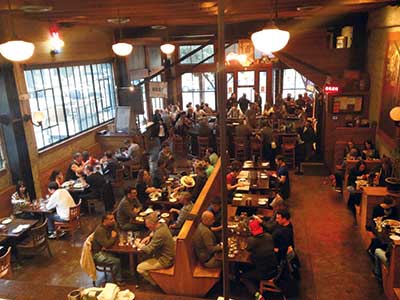 Capacity at 21st Amendment is 148 inside, with 25 tables in the dining room, 5 tables in the front bar area and another 15 tables in the mezzanine loft. The 21st Amendment Brewpub didn't just weather the economic recession along with a less-than-stellar location in a rundown neighborhood, it thrived.
Capacity at 21st Amendment is 148 inside, with 25 tables in the dining room, 5 tables in the front bar area and another 15 tables in the mezzanine loft. The 21st Amendment Brewpub didn't just weather the economic recession along with a less-than-stellar location in a rundown neighborhood, it thrived.
Opening in San Francisco's South of Market neighborhood in 2000, the restaurant now benefits from its location, which has been upgraded to include pricey condos, upscale retail establishments and AT&T Park, home of the San Francisco Giants.
"What a difference it makes to have Giant fans come through six months out of the year," says Rob Strasser, the brew pub's general manager. Even the influx of other eateries hasn't been detrimental to business. "What we bring to the table is much different than the other area restaurants."
Strasser attributes 21st Amendment's success to its beer and the craft brew revolution of the last decade. "For me personally, it had to do with making my own beer and quickly realizing that absolutely anything is possible," he says. "There is this notion of what beer is like, but when you explore incorporating almost any ingredient to make any type of beer you want, it's obvious this is a different animal."
Being able to incorporate food and beer pairing dinners, home brew demonstrations and beer tastings helps the brew pub achieve its goal of not only engaging customers but also immersing them in the craft beer experience.
"And just like we can incorporate any ingredient in beer, we can use our craft beer as an ingredient in our food dishes," says Strasser. "We're able to come up with different ideas for a wide variety of dishes, and beer really enhances the flavors."
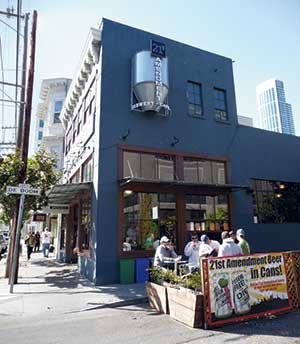 When it opened, 21st Amendment Brewpub’s neighborhood was up and coming. Now the restaurant is benefiting from a baseball stadium down the street.The menu includes beer incorporated into fish-and-chips batter and barbecue sauces, with beer malts used as a key ingredient for pizza dough. Best-sellers include burgers with onions sautéed in beer, ribs with beer-infused sauce, pancakes with blueberries and a dark beer sauce, corned beef with beer au jus and homemade charcuterie platters with beer-infused sausage.
When it opened, 21st Amendment Brewpub’s neighborhood was up and coming. Now the restaurant is benefiting from a baseball stadium down the street.The menu includes beer incorporated into fish-and-chips batter and barbecue sauces, with beer malts used as a key ingredient for pizza dough. Best-sellers include burgers with onions sautéed in beer, ribs with beer-infused sauce, pancakes with blueberries and a dark beer sauce, corned beef with beer au jus and homemade charcuterie platters with beer-infused sausage.
The brewery partners with local suppliers, including a sausage maker and ice cream manufacturer, which produce signature product lines incorporating 21st Amendment's craft beer. "Our Fireside Chat ice cream blends holiday spice ale, and we also have incorporated Monk's Blood, a dark
Belgian ale, into ice cream," says Strasser.
Sitting separate from the kitchen is the brewery, which consumes about 35 percent of the back of house. The brewery includes 12 barrels, 4 fermenters, a mash ton that doubles as a lager ton, a kettle and 6 bright tanks that have been custom welded vertically to conserve space.
The kitchen includes two pizza ovens, a six-burner stove with an oven, two fryers, a grill and a large mixer. A griddle recently replaced a four-burner stove to toast burger buns and fry pancakes. Naturally, refrigeration represents a key equipment component for both a brewery and a restaurant. In this instance, the refrigeration package includes three lowboys in the kitchen line, five freezers and walk-in coolers in both the kitchen and brewery.
The restaurant can seat up to 148 customers inside, with 25 tables in the dining room, 5 tables in the front bar area and another 15 tables in the mezzanine loft. After more than a year's worth of negotiations with the city, 21st Amendment was recently able to add a beer garden. Regulations require the area to be completely broken down every night by 10 p.m. "We sourced an architect who designed a 3,000-square-foot beer garden corral configuration," says Strasser.
The entire area breaks down into interlocking segments and stores against the building. Tables act as lynchpins to hold one section onto another, protruding only 5 inches from the building when stored. The aircraft aluminum bar folds into a 4-inch imprint upon closing. A closet built into the side of the building contains the bar and tent. It takes only 20 minutes to set up the 10 tables and 40 chairs.
Now 21st Amendment operates a second and more extensive 150,000-square-foot production brewery in nearby San Leandro as well. This allowed the burgeoning brewery to expand production and distribution. This location includes a tasting room with picnic tables built from canning line pallets and used chairs from a shuttered restaurant chain.
The San Leandro location will eventually include a bocce court in the tasting room and will incorporate a restaurant with a large commissary-style kitchen and event space.
"The San Francisco pub is busy but packed, and our new facility has a vast amount of space," says Strasser. "We'll probably start finishing up design ideas in the next year and anticipate the restaurant opening in about two years."
Capitalizing on Local
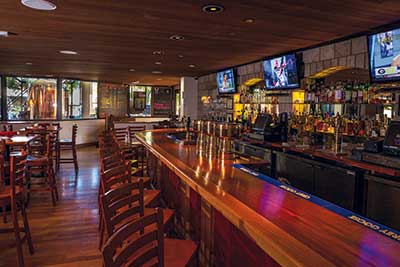 Peter B’s features an American-style menu to complement its five house beers and seven seasonal selections.The locals consider Peter B's Brewpub one of Monterey, Calif.'s best-kept secrets.
Peter B’s features an American-style menu to complement its five house beers and seven seasonal selections.The locals consider Peter B's Brewpub one of Monterey, Calif.'s best-kept secrets.
Although it's located at the Portola Hotel & Spa, the restaurant is largely obscured in the back of the building. Opened in 1996, the operation includes an American-style menu featuring burgers, pasta and tacos, in addition to five house beers and a rotating list of award-winning seasonal selections.
"In terms of our production, we hit 1,050 barrels, which is 32,550 gallons of beer," says Sonny Petersson, director of food and beverage at the Portola Hotel & Spa. "Most of the beer brewed is sold on property, but we also bottle and sell kegs to local bars and restaurants throughout Monterey County."
Barrel-aged beers surround the restaurant's private barrel room, which customers can reserve for parties. The foodservice operation includes a large kitchen with two main lines that support the menus for both Peter B's and Jacks Restaurant & Lounge, the hotel's fine-dining operation.
Best-selling menu items at Peter B's include the Portola burger, nachos and cheese curds. A separate beer menu suggests food pairings that take into consideration the food's spices and the body of the beers. Since the Portola Hotel is a tourist destination, its five-beer sampler is popular.
"Brew pubs are flourishing because everyone wants handmade craft ales," says Petersson. "This coincides with the local movement and artisanal trends. And there are many components in beer, so we have a lot to work with, such as hops, barley, water and yeast. If any ingredient is changed, the flavor is altered."
The many components involved make operating a brew pub a big undertaking, Petersson says. Peter B's glass-encased steam-operated brewery measures approximately 1,000 square feet. Equipment includes a 500-gallon steam kettle, four 500-gallon fermenters and glycol-cooled systems that are run through jackets on fermenters. Raw malted barley is steeped in giant tea bags.
Craft beer's continued popularity has resulted in more operators wanting to drive home the experience through the use of various types of glassware that will accentuate the features of a particular brew. For example, tall, slender glassware is slated for wheat beer, since this shape enhances the golden beverage color. An IPA is best served in an English-style glass with a bubble inside.
"We all drink with our eyes, so glassware use is important with craft beer," says Petersson. "A typical tumbler would ruin the experience."
This year, Peter B's will expand its production with the installation of a mill and auger system to grind barley on site. "There can be a brew pub on every corner, yet we'll all brew something different with our own techniques and flavors," says Petersson. "That's the beauty of craft beer."




